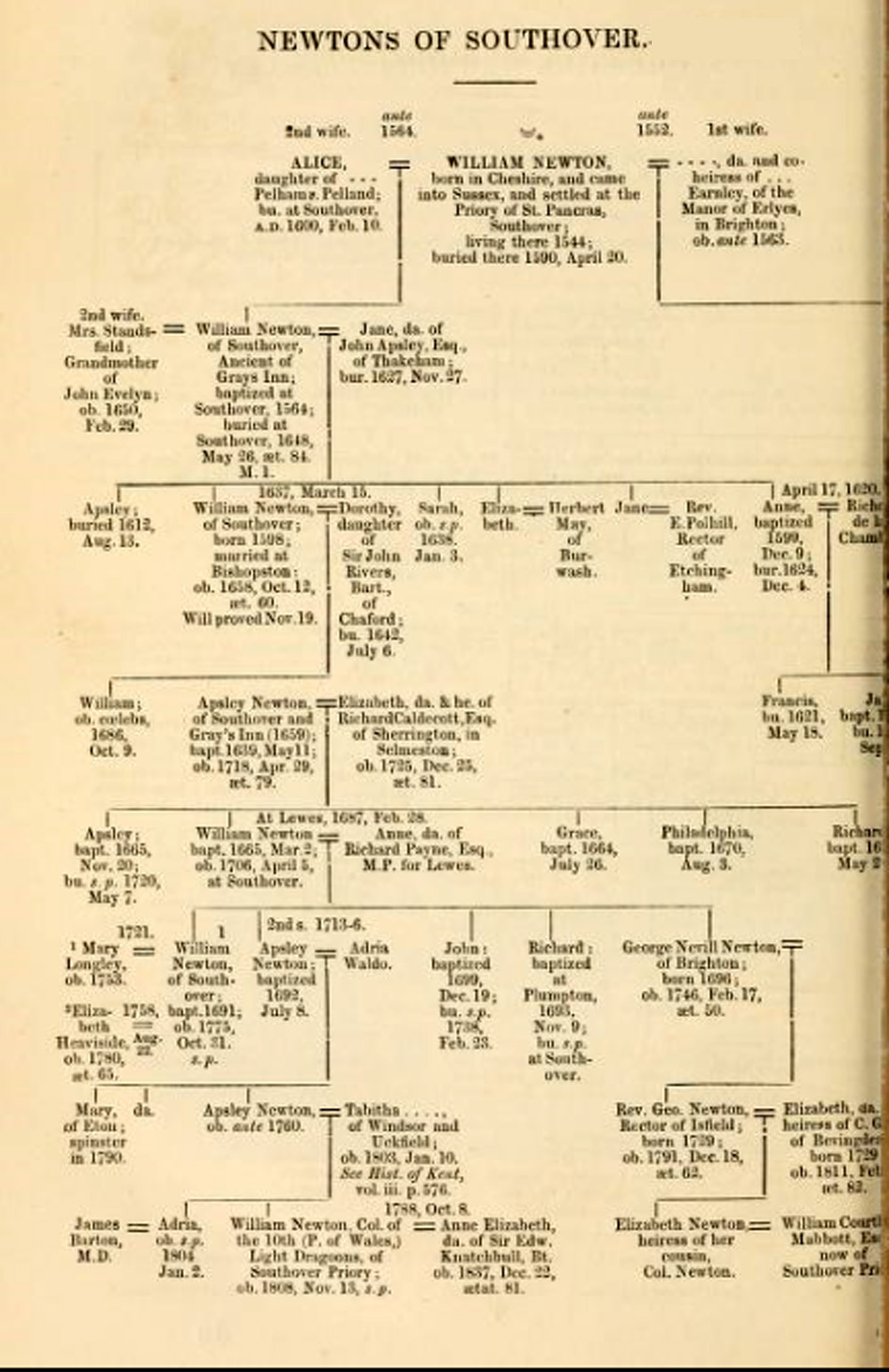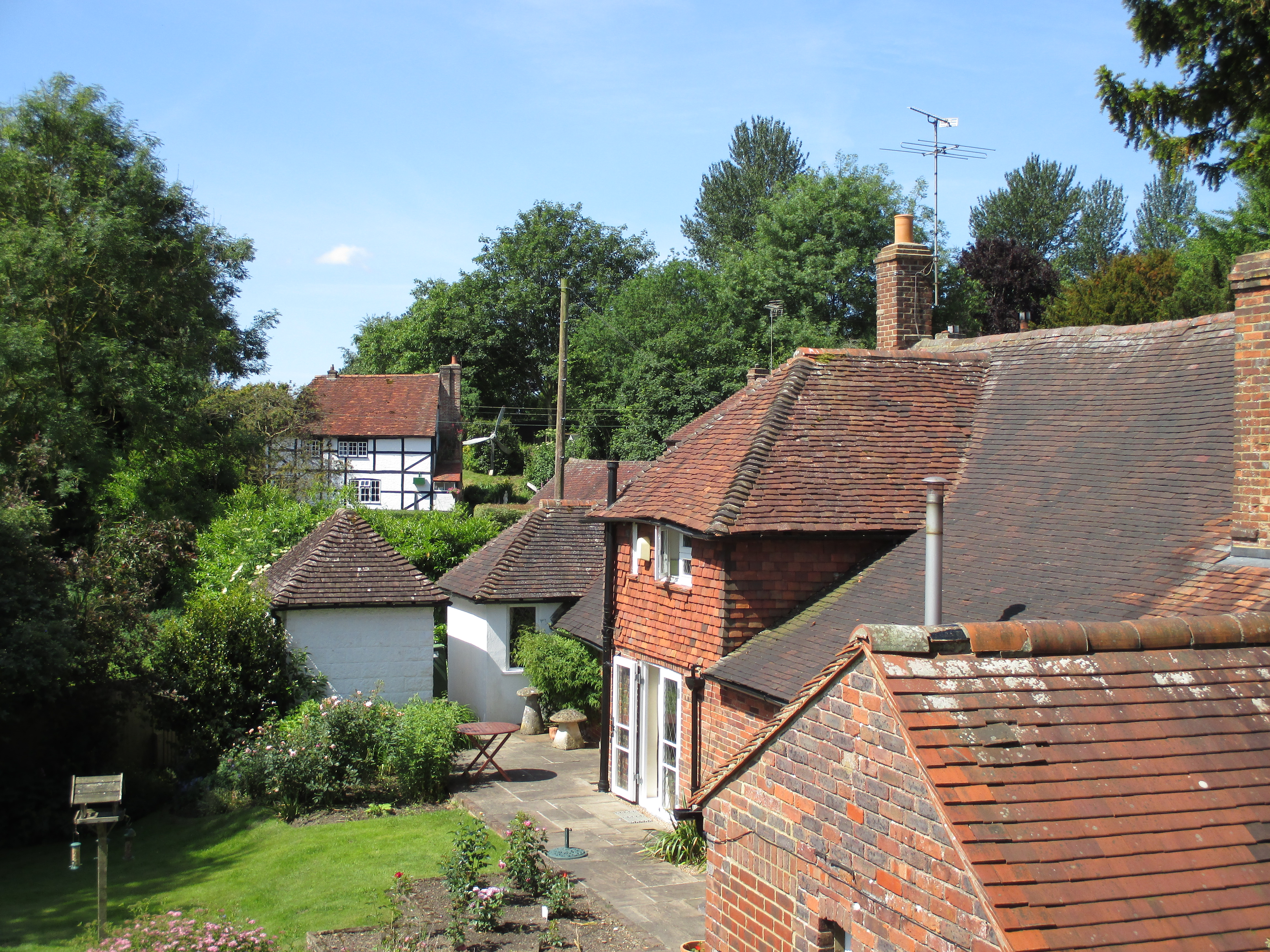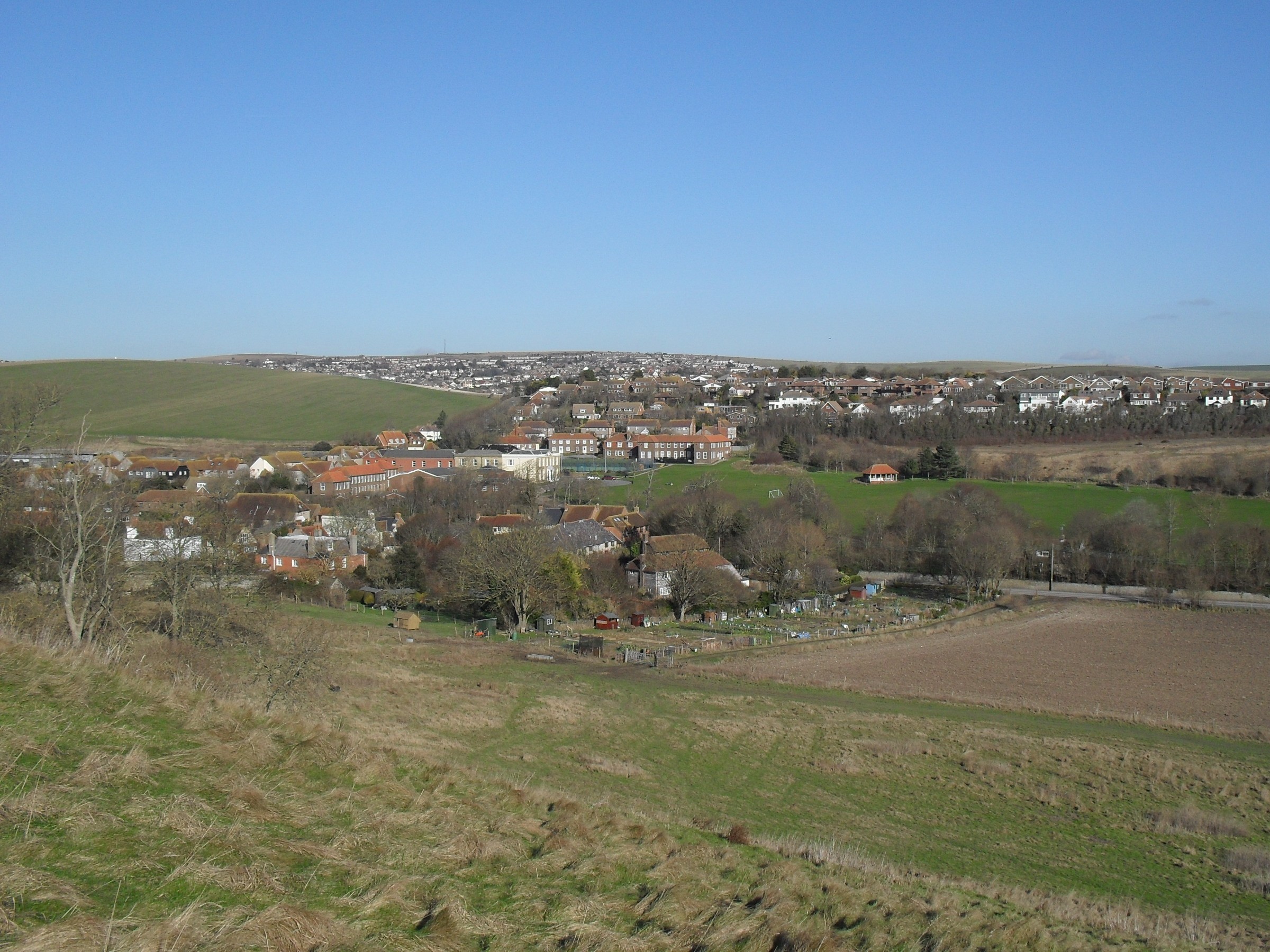|
Southover Grange
Southover Grange in Lewes, Sussex is a house of historical significance and is Grade II* listed on the English Heritage Register. It was built in 1572 by William Newton and owned by this family for the next three hundred years. After this it was the residence of many notable people until it was bought by the local Council in about 1945. Today it is owned by the East Sussex County Council. It now houses the Lewes Register Office which provides Marriage Ceremony Packages, civil partnerships and citizenship ceremonies. The gardens host events from local theatre to beer an gin festivals. The Newton family William Newton (1512–1590) built Southover Grange in 1572. He was born in 1512 in Cheshire and was the second son of Humphrey Newton of Fulshaw and grandson of the notable Humphrey Newton (1466–1536) of Pownall His mother was Ethelred Starkey an heiress of her father Lawrence Starkey and brought into the family extensive properties in York, Lancaster, Chester and Stafford. In 1 ... [...More Info...] [...Related Items...] OR: [Wikipedia] [Google] [Baidu] |
Southover Grange
Southover Grange in Lewes, Sussex is a house of historical significance and is Grade II* listed on the English Heritage Register. It was built in 1572 by William Newton and owned by this family for the next three hundred years. After this it was the residence of many notable people until it was bought by the local Council in about 1945. Today it is owned by the East Sussex County Council. It now houses the Lewes Register Office which provides Marriage Ceremony Packages, civil partnerships and citizenship ceremonies. The gardens host events from local theatre to beer an gin festivals. The Newton family William Newton (1512–1590) built Southover Grange in 1572. He was born in 1512 in Cheshire and was the second son of Humphrey Newton of Fulshaw and grandson of the notable Humphrey Newton (1466–1536) of Pownall His mother was Ethelred Starkey an heiress of her father Lawrence Starkey and brought into the family extensive properties in York, Lancaster, Chester and Stafford. In 1 ... [...More Info...] [...Related Items...] OR: [Wikipedia] [Google] [Baidu] |
Thakeham
Thakeham's History Thakeham is a village and civil parish located north of the South Downs in the Horsham District of West Sussex, England. The village is situated approximately 12 miles south-west of Horsham and 11 miles north of the sea-side town of Worthing. Its nearest large village is Storrington (3 miles). The parish includes the hamlets of Abingworth and Goose Green and has a land area of 1170.6 hectares (2891 acres) The village is mentioned in the Domesday Book,(as Taceham) but human occupation goes back to Neolithic times. The name Thakeham means “thatched homestead” and the original village had just one main street (“The Street”) which is home to the village's only pub, The White Lion, and St Mary's church (12th century) and is now a designated conservation area. Towards the end of World War 1, from February 1917 until February 1918, there was a Royal Flying Corps Home Defence day and night landing ground in the north of Thakeham Parish abutting S ... [...More Info...] [...Related Items...] OR: [Wikipedia] [Google] [Baidu] |
Battle Of Waterloo
The Battle of Waterloo was fought on Sunday 18 June 1815, near Waterloo, Belgium, Waterloo (at that time in the United Kingdom of the Netherlands, now in Belgium). A French army under the command of Napoleon was defeated by two of the armies of the Seventh Coalition. One of these was a British-led coalition consisting of units from the United Kingdom of Great Britain and Ireland, United Kingdom, the Netherlands, Kingdom of Hanover, Hanover, Duchy of Brunswick, Brunswick, and Duchy of Nassau, Nassau, under the command of the Duke of Wellington (referred to by many authors as ''the Anglo-allied army'' or ''Wellington's army''). The other was composed of three corps of the Kingdom of Prussia, Prussian army under the command of Field Marshal Gebhard Leberecht von Blücher, von Blücher (the fourth corps of this army fought at the Battle of Wavre on the same day). The battle marked the end of the Napoleonic Wars. The battle was contemporaneously known as the Battle of Mont Saint-J ... [...More Info...] [...Related Items...] OR: [Wikipedia] [Google] [Baidu] |
Hampshire
Hampshire (, ; abbreviated to Hants) is a ceremonial county, ceremonial and non-metropolitan county, non-metropolitan counties of England, county in western South East England on the coast of the English Channel. Home to two major English cities on its south coast, Southampton and Portsmouth, Hampshire is the 9th-most populous county in England. The county town of Hampshire is Winchester, located in the north of the county. The county is bordered by Dorset to the south-west, Wiltshire to the north-west, Berkshire to the north, Surrey to the north-east, and West Sussex to the south east. The county is geographically diverse, with upland rising to and mostly south-flowing rivers. There are areas of downland and marsh, and two national parks: the New Forest National Park, New Forest and part of the South Downs National Park, South Downs, which together cover 45 per cent of Hampshire. Settled about 14,000 years ago, Hampshire's recorded history dates to Roman Britain, when its chi ... [...More Info...] [...Related Items...] OR: [Wikipedia] [Google] [Baidu] |
Bevendean
Bevendean is a district of the city of Brighton and Hove, in East Sussex, England. The estate lies to the north-east of central Brighton, and was largely developed after World War II with a mixture of council housing and private development. A large proportion of the council houses are now privately owned. The area has limited local facilities and there is only one road access route into and out of the area. The manor of Bevendean was recorded in the Domesday Book of 1086. The name is derived from 'Beofa's valley'. It was later divided into two estates, Upper Bevendean on the hill and Lower Bevendean in the valley. Some housing development began in the 1930s, with the population expanding rapidly from 1948 onwards. An industrial estate was developed from the mid-1950s. The two local churches are: the Church of the Holy Nativity, built in 1963 as a Modern-style building in brick by architect Reginald Melhuish, ARIBA, and The Salvation Army - which occupies a building that ... [...More Info...] [...Related Items...] OR: [Wikipedia] [Google] [Baidu] |
Ovingdean
Ovingdean is a small, formerly agricultural, village in the east of Brighton and Hove, East Sussex, England. Overview It was absorbed into the administrative borough of Brighton, East Sussex, England in 1928, and now forms part of the city of Brighton and Hove. It has expanded through the growth of residential streets on its eastern and southern sides, and now has a population of about 1,200. Some of the current housing replaces earlier shacks of the type once found in neighbouring Woodingdean and Peacehaven, built after the First World War. It almost abuts Rottingdean to the south-east and Woodingdean to the north-east, but still has open downland on its other sides, on which may be found a golf course and Brighton racecourse as well as some residual farmland. The name, which is Old English for 'the valley of people associated with a man called Ōfa', shows that the village has existed since Anglo-Saxon times. Little seems to have disturbed its peace since. It is sometimes sa ... [...More Info...] [...Related Items...] OR: [Wikipedia] [Google] [Baidu] |
Isfield
Isfield is a small village and civil parish in the Wealden District of East Sussex in England, located north-east of Lewes.OS Explorer map Eastbourne and Beachy Head Scale: 1:25 000. Publisher:Ordnance Survey – Southampton B2 edition. Publishing Date:2009. History The village of Isfield originally grew adjacent to the ford where the London to Lewes Way Roman road crossed the river River Ouse. The village had an active history through the Saxon, Norman eras, when a Norman castle motte was built on the river bank near the church to guard the crossing. Local legend, as recalled by William Wratten, had it that King Harold spent the night before the Battle of Hastings in the village, at his demesne located where Isfield Place now stands. Isfield became the home of John Shurley (died 1527), who was Cofferer of the Household to King Henry VIII. Isfield Place is a 17th-century manor house, incorporating part of the original 16th-century mansion of the Shurley family. Its design ... [...More Info...] [...Related Items...] OR: [Wikipedia] [Google] [Baidu] |
Tithe Map Of Southover Circa 1840
A tithe (; from Old English: ''teogoþa'' "tenth") is a one-tenth part of something, paid as a contribution to a religious organization or compulsory tax to government. Today, tithes are normally voluntary and paid in cash or cheques or more recently via online giving, whereas historically tithes were required and paid in kind, such as agricultural produce. After the separation of church and state, church tax linked to the tax system are instead used in many countries to support their national church. Donations to the church beyond what is owed in the tithe, or by those attending a congregation who are not members or adherents, are known as offerings, and often are designated for specific purposes such as a building program, debt retirement, or mission work. Many Christian denominations hold Jesus taught that tithing must be done in conjunction with a deep concern for "justice, mercy and faithfulness" (cf. Matthew 23:23). Tithing was taught at early Christian church councils, ... [...More Info...] [...Related Items...] OR: [Wikipedia] [Google] [Baidu] |
Southover Grange 1850
Lewes () is the county town of East Sussex, England. It is the police and judicial centre for all of Sussex and is home to Sussex Police, East Sussex Fire & Rescue Service, Lewes Crown Court and HMP Lewes. The civil parish is the centre of the Lewes local government district and the seat of East Sussex County Council at East Sussex County Hall. A traditional market town and centre of communications, in 1264 it was the site of the Battle of Lewes. The town's landmarks include Lewes Castle, Lewes Priory, Bull House (the former home of Thomas Paine), Southover Grange and public gardens, and a 16th-century timber-framed Wealden hall house known as Anne of Cleves House. Other notable features of the area include the Glyndebourne festival, the Lewes Bonfire celebrations and the Lewes Pound. Etymology The place-name 'Lewes' is first attested in an Anglo-Saxon charter circa 961 AD, where it appears as ''Læwe''. It appears as ''Lewes'' in the Domesday Book of 1086. The addition of ... [...More Info...] [...Related Items...] OR: [Wikipedia] [Google] [Baidu] |
Jane Austen
Jane Austen (; 16 December 1775 – 18 July 1817) was an English novelist known primarily for her six major novels, which interpret, critique, and comment upon the British landed gentry at the end of the 18th century. Austen's plots often explore the dependence of women on marriage in the pursuit of favourable social standing and economic security. Her works critique the novels of sensibility of the second half of the 18th century and are part of the transition to 19th-century literary realism. Her use of biting irony, along with her realism and social commentary, have earned her acclaim among critics, scholars and readers alike. With the publication of ''Sense and Sensibility'' (1811), '' Pride and Prejudice'' (1813), ''Mansfield Park'' (1814), and '' Emma'' (1816), she achieved modest success but only little fame in her lifetime since the books were published anonymously. She wrote two other novels—''Northanger Abbey'' and '' Persuasion'', both published posthumou ... [...More Info...] [...Related Items...] OR: [Wikipedia] [Google] [Baidu] |
Sir Edward Knatchbull, 9th Baronet
Sir Edward Knatchbull, 9th Baronet, (20 December 1781 – 24 May 1849) was a British Tory politician. He held office under Sir Robert Peel as Paymaster of the Forces between 1834 and 1835 and as Paymaster-General between 1841 and 1845. Background and education Knatchbull was the son of Sir Edward Knatchbull, 8th Baronet, and Mary, daughter and heiress of William Western Hugessen, of Provender House in Norton, Kent, and was educated at Christ Church, Oxford and matriculated in 1800. He was elected a Fellow of the Royal Society in 1802 and was called to the Bar at Lincoln's Inn in 1803. In 1819 he succeeded in the baronetcy on the death of his father. Political career Knatchbull was elected as a Member of Parliament (MP) for Kent at a by-election in November 1819, to fill the vacancy caused by the death of his father. He held the seat until the 1831 general election, which he did not contest. The Reform Act 1832 split the Kent county constituency into Eastern and Wester ... [...More Info...] [...Related Items...] OR: [Wikipedia] [Google] [Baidu] |
Sir Edward Knatchbull, 7th Baronet
Sir Edward Knatchbull, 7th Baronet (12 December 1704 – 21 November 1789) was an Irish politician. He was the third son of Sir Edward Knatchbull, 4th Baronet and Alice Wyndham, daughter of Colonel John Wyndham. In 1763, he succeeded his nephew Sir Wyndham Knatchbull-Wyndham, 6th Baronet as baronet. Knatchbull was a Member of Parliament (MP) for Armagh Borough in the Irish House of Commons from 1727 until 1760. Knatchbull married Grace Legge, second daughter of William Legge. They had five daughters and three sons. He died, aged 84, and was succeeded in the baronetcy by his only surviving son Edward Edward is an English given name. It is derived from the Anglo-Saxon name ''Ēadweard'', composed of the elements '' ēad'' "wealth, fortune; prosperous" and '' weard'' "guardian, protector”. History The name Edward was very popular in Anglo-Sa .... References 1704 births 1789 deaths Baronets in the Baronetage of England Irish MPs 1727–1760 Members of the ... [...More Info...] [...Related Items...] OR: [Wikipedia] [Google] [Baidu] |








